#גדולים
Explore tagged Tumblr posts
Text
זה כמו מה שהיה בקפיטול מה זה השטויות האלה
#text#ישראבלר#חמומי מוח קטנים שמובלים ע''י חמומי מוח גדולים#באיזה קטע הם מעיזים לפרוץ לבסיס צבאי??#באיזה קטע לא מעיפים אותם משם בכוח??#וואי וואי וואי אם השמאל היה רק מתקרב לבסיס צבאי מה הימין היה אומר#אבל פה זה פטריוטיות איי גאס#חובה עלינו לפרוץ לבסיסים ולעצור את הפעילות השוטפת של צה''ל! למה? ככה!#יאללה מתי עוצמה יהודית יוצאת מחוץ לחוק?
8 notes
·
View notes
Text
הו הו הו ��מה פסטיגלים ראיתי בתקופתי! אני זוכרת ששרית חדד הייתה חלק מכל כך הרבה פסטיגלים בסוף התשעים/תחילת אלפיים.
אני גם זוכרת כשיצא השיר עם חברים בכל מיני צבעים, זה היה קולצ'ורל ריסט.
היה פסטיגל שלם על טלנובלות. היה אחד על המילניום עם כוכבי לכת מוזרים. משהו גם עם צעצועים שקמים לתחייה?
רובי דואניאס היה הרשע האולטימטיבי בכל מופע חנוכה בתקופה הזאת, הולי שיט הוא הביא לי סיוטים.
אליאנה תדהר? פחח הקומבו של יעל בר זוהר ומיכל ינאי רושש את הכיסים של כל ההורים. זה היה השיא של ערוץ הילדים, כמעט כל מנחה השתתף בפסטיגל כלשהו.
והקלטות! הדיסקים! כל נסיעה באוטו שמים את הדיסק של הפסטיגל התורן שהיה באותה השנה.
אההה ותחרות השירים!!!!!! היו מחלקים פתקי הצבעה לכל הקהל והילדים היו בוחרים איזה שיר יהיה המנצח של הפסטיגל באותה השנה וזה היה מטורף בתור ילדה חחח היו תיבות כאלה ביציאה והיינו שמים שם את הפתקים ואשכרה מחכים בקוצר רוח לגלות מי הזוכה. להבדיל מבחירות בתור אדם בוגר שהן מעפנות כי אין את טל מוסרי.
כן. אני זוכרת הכל.

מישהו בכלל ראה את הפסטיגלים לפני "לא יאומן כי פסטיגל"? כי אני לא חושבת שראיתי מישהו מזכיר אותם אפילו
#text#ישראבלר#זהו אני קשישה#אני חושבת שהפסטיגל האחרון שלי היה... 2005 או 2006? משהו כזה#אז כבר הרגשתי שעברתי את הגיל חח#אוי וגם כל הכותבים הכי גדולים במדינה אשכרה כתבו את השירים למופע#אהוד מנור ועוזי חיטמן אולי אפילו נעמי שמר בתקופות מוקדמות יותר#גאד כמה נוסטלגיה
23 notes
·
View notes
Text

[ID: A pyramid of crystalline snow topped with deep orange syrup on a bright blue plate. End ID]
بقسمة / Buqsuma (Palestinian snow dessert)
بُقْسُمَة ("buqsuma"), or بوظة الشتاء ("būẓa shitā'", "winter ice cream"), is a dessert, possibly of Aramaic origin, eaten in cold and mountainous rural regions within Palestine, Syria, Jordan, Lebanon, and Turkey. It consists of freshly fallen snow topped with grape molasses (دبس العنب; "dibs al-'inab"), date molasses, pomegranate molasses, or storebought snow syrup (شراب الثلج ; "shrāb aṯ-ṯalj"). In Lebanon it may be topped with honey or orange syrup; and in Syria and Lebanon it may also be called سويق or سويقة ("sawīq" or "sawīqa").
Buqsuma is eaten for only a few days a year at the end of the snowy season in February. An old rhyme cautions against eating snow too early in the season:
أول تلجة دم تانية تلجة سم تالتة تلجة كل ولا تهتم
("ʔawwal tallaja damm "tānya tallaja samm "tālta tallaja kul wa lā tahtamm")
("The first snowfall is blood "The second snowfall is poison "The third snowfall, eat and don't worry")
Journalist Hussein Saqr speculates that the intention may be to allow the first snows to clear the air from summer and fall dust and other pollutants before the snow is safe to consume.
During these late winter days, eating and sharing buqsuma becomes a social ritual; guests are invited to share the dessert from a wide platter, or given individual bowls to dress to their taste with syrup, milk, and sugar. Children bring bowls of snow inside and eat buqsuma by the fire to warm up and recuperate from a day at play.
In Syria, buqsuma is prepared especially in the مُحافظة السويداء ("Muḥāfaẓat as-Suwaydā'"; Suwayda Governorate) in the south; in the طرْطوس ("Ṭarṭūs") and إدلب ("'Idlib") Governorates in the northeast; and along the جبال لبنان الشرقية ("Jibāl Lubnān ash-Sharqiyya"; Anti-Lebanon mountain range) from جبل الشيخ ("Jabal ash-Shaykh"; Mountain of the Sheikh / "Mount Hebron") to the جبال القلمون ("Jibāl al-Qalamūn"; Qalamoun Mountains) in Damascus Governorate.
In Palestine
Within Palestine, buqsuma is eaten only in الخليل ("Al-Khalīl" / "Hebron"), in the occupied West Bank. Palestinian food writer Reem Kassis points out that the regional specificity of the dish is due to the nature of the land: Al-Khalil is one of the few places in Palestine to receive snow.
Al-Khalil is also famous for its viticulture. "It is well known among Palestinians that Al-Khalil grows the best grapes," according to embroidery artist Wafa Ghnaim. Though grape vines have existed in Palestine since antiquity, Al-Khalil was one of the few locales to maintain them even during the Crusades, which caused the abandonment of olive and grape orchards elsewhere. As with oranges and pomegranates, an association between terroir, agriculture, and design reveals itself in Palestinian art: the قطف عنيب ("qiṭf 'inab"; "bunch of grapes") motif is common in Al-Khalil embroidery (تطريز; "taṭrīz"; often transliterated "tatreez").
Around 1700, Rabbi Gedalia mentions Al-Khalil's grapes as being particularly praiseworthy:
ויש בא"י הרבה פירות האילן, כגון ענבים, תאנים, ורמונים, זתים […]. והענבים הם גדולים ועגולים בירושלים. אבל בחברון תוב"ב הם מרובים וגדולים מן הענבים אשר בירושלים. וכשמוכרים את הענבים של חברון בירושלים משבחים אותם וצועקים: בואו ותקנו הענבים של חברון ! ומענב אחד מתמלא הפה ממשקה. And there are in the land of Israel many tree fruits, such as grapes, figs, pomegranates, and olives [...]. The grapes are big and round in Jerusalem, but in Hebron they are more numerous and larger than the grapes in Jerusalem. And when vendors sell the grapes of Hebron in Jerusalem, they praise them and shout: Come and buy the grapes of Hebron! And one grape fills the mouth with nectar. (pp. 337-8)
Al-Khalil's viticulture is closely integrated with Palestinian food culture. Three distinct harvests yield different products. In the early spring, some of the leaves from the grape vines (وَرَق الدوالي; "waraq ad-dūwāli") will be harvested, when they are young, tender, and sour: good for stuffing with rice, meat, and vegetable fillings to make several popular Palestinian dishes.
Later in the spring, grape farmers harvest early, sour grapes (حصرم; "ḥiṣrim"; Levantine dialect "ḥuṣrum"). Some of these will be pressed to make عصير حصرم ("'aṣīr ḥuṣrum"; "juice of sour grapes"), a tart liquid that may be drunk plain, or used to give acidity to soups or salads. Others will be pickled in brine, or dried and ground to make a sour condiment called "سماق الحصرم" ("sumāq al-ḥuṣrum," "sour grape sumac").
The third harvest is in the late summer, when the grapes have fully ripened. Grape farmers in Al-Khalil may sell some of their summer harvests to Palestinian wineries and arak distilleries. Other ripe grapes will be pressed and their juice boiled down and dried to produce مَلبَن ("malban"), a Levantine fruit leather. And still more of this juice will be reduced into dibs al-'inab, which is then used to make buqsuma, added to tea as a sweetener, or mixed into tahina and scooped up with bread; it is especially popular during Ramadan as a quick way to boost energy.
Dibs al-'inab has been produced in Palestine for hundreds of years. Rabbi Gedalia describes grape molasses, which he calls "grape honey" ("דבש של ענבים"; "dvash shel 'anavim"):
שמבשלים את התירוש היוצא מן הענבים מיד כשסוחטין אותן, והוא אז מתוק מאוד כדבש ממש, וכ"כ מבשלים עד שנעשה עב כמו דבש. They cook the must which is expressed from the grapes immediately after they are squeezed. It is then very sweet, like real [bee's] honey. Then they cook it again until it becomes thick as honey. (p. 338)
The recipe below is for buqsuma with Al-Khalil-style grape molasses.

[ID: An extreme close-up on snow crystals topped with syrup in bright white and various shades of orange; bubbles are trapped throughout the syrup. End ID]
Viticulture Under Occupation
Today, the tending and harvesting of grapes in Al-Khalil take place under the shadow of Israeli settlements. Israel encourages the transfer of settler populations to settlements in Al-Khalil—including particularly fervent Israeli nationalist cells in the middle of Palestinian areas—with financial incentives and the creation of infrastructure that only settlers can move through freely. Palestinians are forbidden to drive in the "H2" area of Al-Khalil, which encompasses the central Old City and the الحرم الإبراهيمي ("Al-Ḥaram al-Ibrāhīmī"; Sanctuary of Abraham), and has been under Israeli military control since 1997. Israel conducts regular raids in the nominally Palestinian "H1" area, forcing people to leave their homes, destroying property, and committing arbitrary arrests and imprisonments.
The rapid expansion of settlements in the areas around Al-Khalil, such as those in what Israel calls גּוּשׁ עֶצְיוֹן (“Gush Etzion”; Etzion Bloc) and גִּבְעַת חַרְסִינָה ("Givat Harsina"), pushes Palestinians into ever-smaller and denser areas surrounded by settlements, rendering them still more vulnerable to Israeli control.
Alessandro Petti describes the strategy by which Israel fragments and isolates Palestinian areas, while allowing flow of movement between territories for non-Palestinians, as a distinction between free-flowing settler "archipelagoes" and Palestinian "enclaves." Infrastructure such as patrols, roadblocks, barriers, curfews, strip-searches and thorough searches of luggage—to which only Palestinians are subjected—make travel a time-consuming, nerve-wracking, and uncertain process: one that may end with being denied a permit, turned back from a border, or jailed for driving on a road which turns out to be prohibited to Palestinians. Because the rules are constantly changing, Palestinians may continue to avoid a road that is no longer actively barricaded out of fear that attempting to traverse it will lead to arrest.
Official Israeli military policy and settler violence alike cast a pall on Palestinian agricultural tradition and innovation. Farming and shepherding communities in the southern hills of Al-Khalil have been subjected to harassment, home demolition, and forced displacement at the hands of settlers and military bulldozers. Settlers burn grape and olive orchards and cut down mature grape vines. Palestinians are no longer allowed to access ancestral agricultural land that has been overtaken by colonists. Israeli military orders and settler harassment emptied Al Khalil's Old Souq of its vegetable and fruit markets in 2000; in 2019, plans were made to raze Palestinian shops and build a new settlement atop them. These plans would move forward in July of 2023.
Reprisal and collective punishment in the wake of militants' October 7th attacks on settlers have been felt in the West Bank and also impact agriculture in Al-Khalil. Grapes rot on the vine with farmers forbidden to tend them. Streets have been closed, shutting Palestinian farmers into their homes, while Palestinian shepherds in villages in the Al-Khalil area have been displaced and harassed with drones. Settler attacks and destruction of crops, already on a continual uptick for the previous several years, increased to a new high in 2023.
Olives, Grapes, and Resistance
Agriculture has been an important site of Palestinian resistance to settler incursion as, despite harassment, surveillence, and violence, Palestinians insist on staying on their land and in their homes. The Palestinian minority who inhabit the H2 area of Hebron, continuing to tend their olive trees, prevent the area from becoming settler-only and keep alive the hope that Al-Khalil will not become a "ghost town."
Various projects based in Al-Khalil combat settler technologies and strategies. Farmers in Al-Khalil launched the Cooperative Society for Agricultural Marketing and Processing in 1984 to increase grape farmers' self-sufficiency, reduce produce waste, and contribute to the production of Palestinian grape delicacies. The 2022 Counter Surveillance project, launched by Palestinian activist Issa Amro and artist Adam Broomberg, meets the Israeli security cameras stationed among Al-Khalil's olive groves with its own video feed, livestreamed online and to art museums.
Palestine's annual grape festival at حلحول ("Ḥalḥūl"), just north of Al-Khalil, took place in 2023 as scheduled; farmers displayed boxes of grapes of all colors and varieties, and sold dibs, malban, raisins, and jam. And Palestinian farmers and activists contribute to resurgences of indigenous seed varieties—such as the دابوقي ("dābūqi") grape, historically particularly prominent in Al-Khalil—in an effort to preserve Palestine's biodiversity and economic self-sufficiency.
Buy seeds from the Palestinian Heirloom Seed Library
Help Palestinian families evacuate Gaza
Contribute to an eSIM donation drive
Ingredients:
For the syrup (makes 2/3 cup):
2.5kg (5.5lb) tart green grapes, stems removed
For the base:
A large bowl of fresh snow
If it doesn't snow where you live, you can try making shaved ice using a snowcone machine; putting water in an ice-cream maker until you achieve a slushy texture; or running ice cubes through a blender.
Instructions:
For the syrup:
1. Remove grapes from their stems and rinse.

2. In a large bowl, mash and muddle grapes with your hands or a potato or bean masher; or pass grapes through a blender, food mill, or juicer.
3. Strain mashed grapes through a metal strainer, and then a cheesecloth (if you used a juicer, skip right to the cheesecloth). I had 4 cups (1 litre) of grape juice at this point.

4. Pour grape juice into a thick-bottomed pot with a large diameter, preferably one with a light-colored bottom. Heat on medium to bring to a boil.
5. Continue simmering juice, skimming scum off the surface as it arises. Occasionally wipe down the edges of the pot with a wet pastry brush to prevent sugar from sticking and burning.
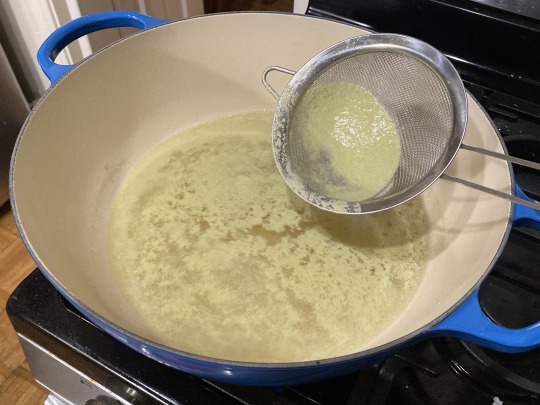
6. Eventually scum will stop rising. Continue to simmer until several shades darker in color and bubbling vigorously. Syrup should still pour freely, and just barely coat the back of a spoon. I had just over 2/3 cup (160 mL) at this point.

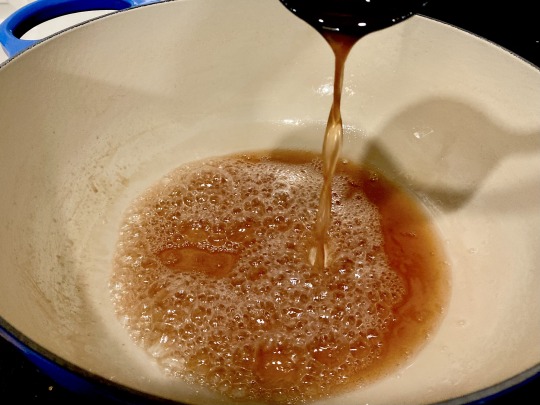
7. Remove from heat and allow to cool slightly before pouring into a jar. Allow to cool to room temperature before refrigerating. If you want to keep the syrup for multiple months or at room temperature, use a sterilized jar.
Compost the grape peels, or reserve to make fruit scrap vinegar.
For the dish:
1. Set a large bowl out several hours into a heavy snowfall; or collect just the top layer of freshly fallen snow after it has been snowing for several hours. Snow that falls earlier in a snowfall, or that has been sitting out for a longer period of time, is more likely to contain pollutants.
2. Compact the snow with a spoon to make the texture homogenous. Some people run it through a blender. Fill individual serving bowls with snow.
3. Pour cooled molasses to taste onto the snow and mix.
251 notes
·
View notes
Text
ברוך הבא למבשלים עם נועם!
והיום: שילוב מקולל בין בורקס לסמבוסק שנוצר מבצק ג'חנון (במילוי פטריות/תרד)
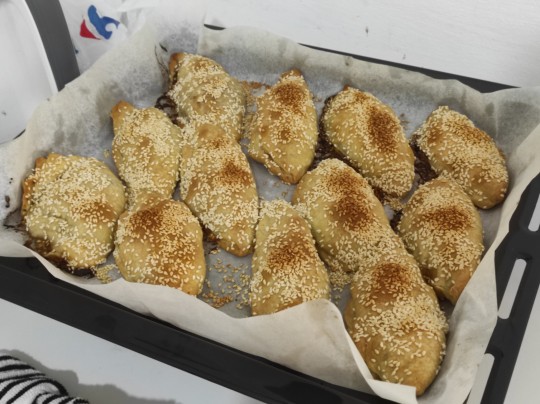
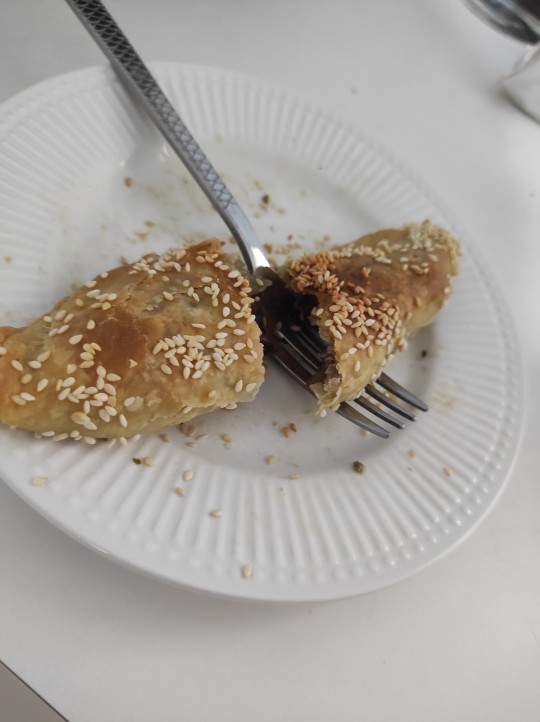
נשבע שיצא לי טעים 💀
(אגב בתמונה יש מזלג כי אכלתי על הצלחת הזאת מקושקשת קודם, אני לא פסיכופת, לא אכלתי את הסמבוסק עם מזלג, אל תהרגו אותי)
המתכון (ל12 זוועות):
לבצק:
2 כוסות קמח חיטה/כוסמין (בתמונה עשיתי חצי חצי בין כוסמין לבן לחיטה לבנה, פעמים הבאות אעשה עם כוסמין מלא)
1/4 כוס שמן זית
140 מ"ל מים פושרים
כפית מלח
קצת חמאה פושרת בקער��
משטח עבודה נקי (שיש כאילו)
למילוי:
חפשו באינטרנט מילויי בורקס/סמבוסק, מה שהכנתי יצא זוועה אני לא משתף את זה 💀
תחממו את התנור מראש ל190°c.
שימו את הקמח בקערה, תעשו גומה כזה באמצע ותשפכו לבפנים את השמן והמלח, ותתחילו לערבב עם יד אחת, עם היד השנייה תשפכו לאט לאט את המים. תערבבו עד שיוצאת לכם תערובת אחידה טיפה דביקה ולא נשאר קמח בקצוות של הקערה. אני ממליץ להשאיר כוס עם טיפה קמח בצד למקרה שזה יוצא דביק מידי וצריך להוסיף.

תצפו את זה ותנו לזה לנוח 15 דקות, אחרי רבע שעה תלושו את זה עוד פעם לכמה דקות ותנו לזה לנוח שעה.
במהלך השעה הזאת אפשר לעבוד על המילויים לזוועות, הנה תמונה של המילוי פטריות והמילוי תרד שהכנתי (קחו בחשבון שזה מלא פטריות והכנתי שישאר לי אקסטרה, וגם נשפך לי מלא בזיליקום כי אני טמבל 💀)
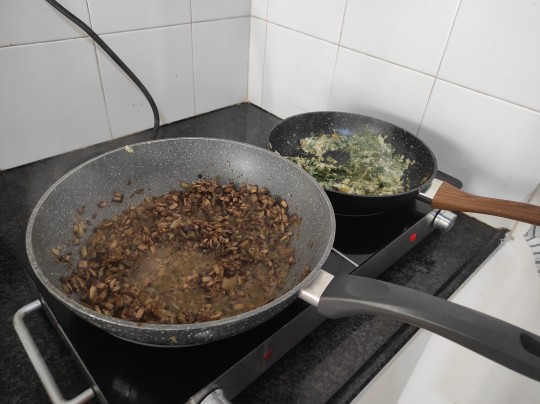
לאחר שעה תחלקו את זה ל12 כדורים (אפשר אפילו יותר אם אתם רוצים לעשות אותם קטנים), ותנו לזה לנוח מכוסה לעוד 15 דקות. תוודאו שיש לכם מגש יותר גדול משלי כי הכדורים המזדיינים האלה יצאו אח''כ מזה גדולים.
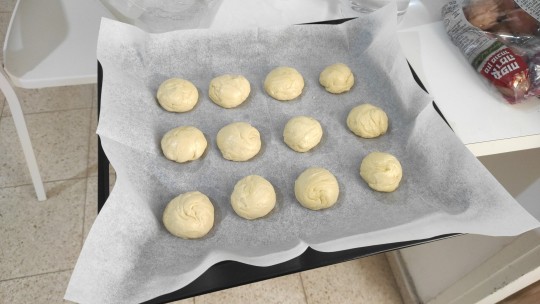
אחרי 15 דקות, תשמנו את השיש עם קצת חמאה, תניחו עליו את הכדור, ותמתחו אותו שיהיה עיגול שטוח (לא מתוח מידי, הוא צריך להיות קצת עבה שהמילוי ישאר בתוכו)
תקחו כף של מילוי לבחירתכם ותניחו על חצי מהעיגול, תוודאו שיש טיפה רווח בקצוות.
קפלו את הבצק לחצי, תוודאו שאתם צובטים טוב טוב את הקצוות, אני ווידאתי את זה ועדיין חצי מהסמבורקסים האלה נפתחו לי. הבצק הזה לא אוהב להידבק לעצמו כי זה בצק ג'חנון שנועד שיהיו לו שכבות.
אחרי שסיימתם אפשר להבריש עליהם עם ביצה ולשפוך חצי דלי של שומשום עד שלא רואים בצק (חשוב מאוד!). אני לא שמתי ביצה והשומשום לא נדבק, למרות שחשבתי על זה, ואמרתי לעצמי על כל גרגיר "למה לא שמת ביצה. למה לא שמת ביצה." :)
תדחפו לתנור ל20 דקות או עד שמזהיב, בכל תנור זה כנראה יהיה אחרת אינלי שמץ.
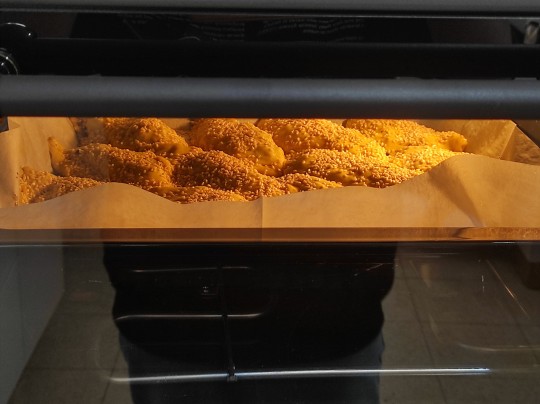
אני שמתי 20 דקות וזה לא הזהיב, אז הוספתי עוד 10 דקות וזה טיפה התחיל להישרף, איזה יופי!
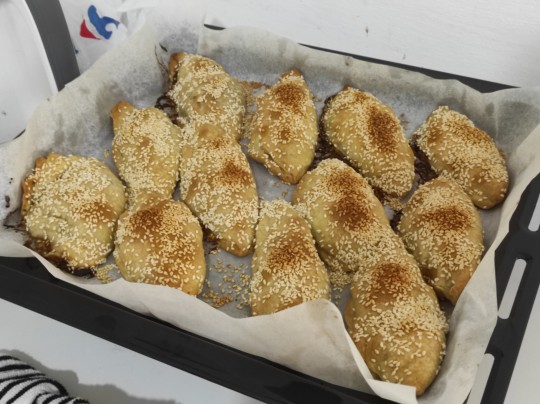
הנה שוב התמונה המוכנה, הבצק כל כך פאקינג טוב אני ממש לא ציפיתי לזה, אני טיפה מתחרט שלא נתתי לו להיות עבה יותר אפילו. נראלי פעם הבאה אני אנסה לחקות יותר בורקסים מאשר סמבוסק כדי שיהיה יותר קראנצ'י. תבלו!
אל תשכחו אח''כ לנקות את כל הכלים, כי יש הרבה.
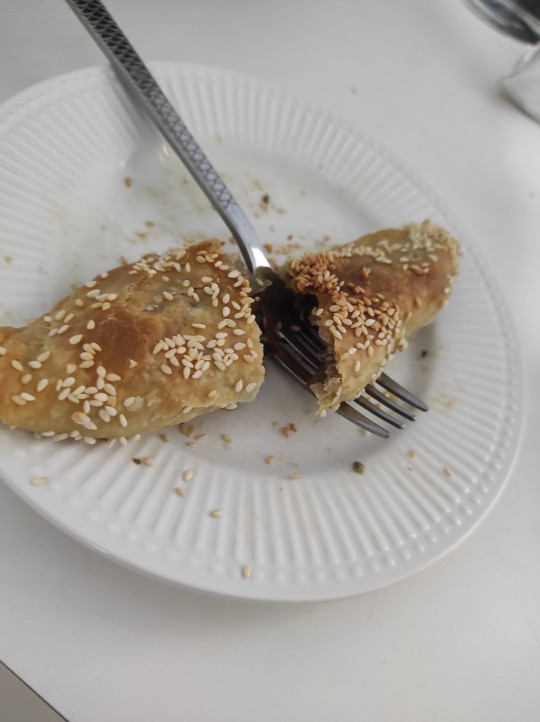
#ישראבלר#אוכל#בישול#מבשלים עם נועם#הבצק. כל כך פריך.#זה נהדר אני נשבע לכם.#ישראלבלר#טאמבלר ישראלי#טאמבלר עברי#עברית#אוכל ישראלי#ישרבלר#if someone wants an english translation tell me#שכחתי לשים read more למתכון וופס
53 notes
·
View notes
Text
"אלא שבכל דור דור עומדים עלינו לכלותינו // והקדוש ברוך הוא מצילנו מידם"
There has never been 18 years in Israel without war
every boy here knows the way to the school shelter.
every girl here knows the sounds of alarm
every father here knows what they mean when they say in Passover when they say "so that in every generation they come for us to destroy us"
Every mother here knows the names of every group of terrorists who want to kill us.
My child will know no war.
My boy will not know the way to the shelter.
My girl will know no alarm
My children will not understand what we mumble on passover
My kids will not know no terrorists
We need to win this war, so that I can honestly tell them, "when you'll grow old, you won't go to the army"
79 notes
·
View notes
Text
Feet types
The artist sneakybluepill_ made this chart with common men’s feet type. I tried to find an example to each type. Which do you like? צייר בשם “סניקיבלופיל” שירטט סוגים נפוצים של כפות הרגליים גבריות. ניסיתי למצוא דוגמא לכל סוג. איזה אתם אוהבים?
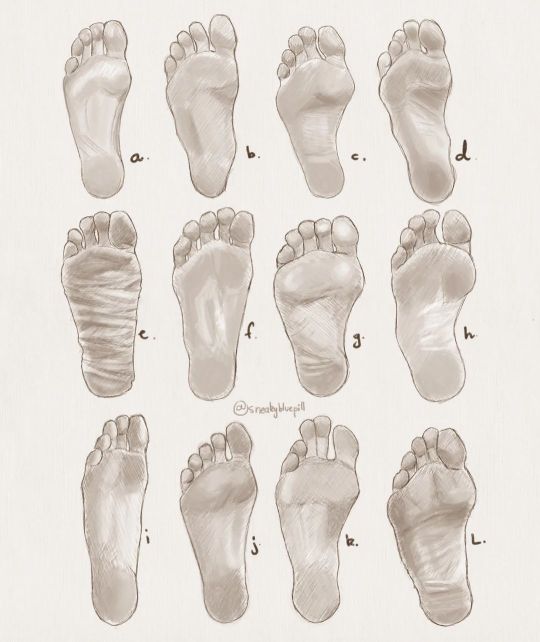
a - israel.d3

b - ImriZiv

c - guylapidd The big toe is lower than the index. Narrow round heel

d - Gal Zinger Wavy margins and Narrow heel. Two foot pads below the pinky toe. שוליים גליים ועקב צר. שתי כריות רגליים מתחת לזרת

e - harel_yarkoni The big and index toe are the same height. The foot is meaty, almost flat with no significant pads and a lot of sexy wrinkles. הבוהן והאצבע שאחריה באותו גובה. הרגל בשרנית, כמעט שטוחה, ללא כריות משמעותיות ועם הרבה קמטים סקסיים

f. Unknown guy

g - Uriel Elituv

h. Orel Butbul Large deep arch and meaty foot pads. קשת גדולה ורחבה עם כריות רגליים בשרניות

i - Yakov Abargil Penis’ head shaped big toe, index and middle toe are the same size. Wide foot pads and large heel. בוהן בצורת ראש פין, האצבע השניה והאמצעית באותו גודל. כריות רגליים רחבות ועקבים גדולים

j - Ido Amar

k - ohadcr Index and middle toe are the highest האצבע השניה והאמצעית הן הגבוהות ביותר

L - Master Arnoldo The big toe is large with a flat tip and is lower from the index toe which is the highest.The foot pads are meaty and wide, bulging to the sides. הבוהן גדולה, בעלת חלק עליון שטוח ונמוכה יותר מהאצבע שלידה שהיא הגבוהה מכולן. כריות הרגליים בשרניות ורחבות, בולטות לצדדים.

291 notes
·
View notes
Text
משהו משהו מספר הnotes שהיה לי על ציורים לפאנדומים גדולים מול הקהילה והתגובות על ציורים לדברים מהארץ-
#אני כל כך אוהבת אתכם אעעעע#לא מתייגת את זה אם אתם רואים אתם רואים#בכל אופן זה נחמד כשיצירה עוברת את ה100 נוטס אבל כשאתם מתחרפנים על דברים שאני יצרתי זה אפילו יותר נחמד
7 notes
·
View notes
Text
עבודה של גדולים יום 2. שעה 1 מתוך 8
משמרת בוקר שהתחילה ב-7. באתי מוקדם והאורח קבוע (אני עובדת במלון) צחק עליי.
כדי להגיע בזמן הייתי צריכה לקום ב-5 (שלום ימי הצבא) וחצי שעה לפני השעון המעורר הייתה אזעקה.
כשהחופף שלי הבין שאין הרבה מה לתת לי לעשות בינתיים, נתנו לי למיין שלוש קופסאות של מפתחות במשרד של מנהל הקבלה.
2 notes
·
View notes
Text
בין שני עננים גדולים - יצחק קצנלסון (''דמדומים: שירים'', תר''ע, 1910)
בֵּין שְׁנֵי עֲנָנִים גְּדוֹלִים, / בֵּין שְׁנֵי עִנְקֵי שְׁחוֹר — / רוֹעֵד כּוֹכָב אֶחָד, / רוֹעֶדֶת קֶרֶן אוֹר…
מָה אֲיוּמִים — אֵלִי! / אֵלֶּה עַנְנֵי עַד; / וּמַה קָּטֹן, חַלָּשׁ / כּוֹכָבִי זֶה הַחַד.
פְּנֵי עֲנָנִים מְפִיקִים; / קֶצֶף, קְלָלָה, מְרִי, / וְכוֹכָב זֶה הַיְחִידִי / מָה הוּא חָבִיב לִי!
לִרְגָעִים יֶחֱרַד לִבִּי / לִי נִדְמֶה עוֹד מְעָט / וְנֶחֱנַק בְּיַם הַחֲשֵׁכָה / כּוֹכָבִי זֶה הַקָּט.
אָנָא, עַנְנֵי זַעַם, / אַל תִּפְעֲרוּ פֶה, / לִבְלֹעַ אֶת חֲבִיבִי — / אֶת כּוֹכָבִי זֶה.
הוֹי, מַה גָּדוֹל יִהְיֶה / עָנְיִי, צַעֲרִי אָז — / בְּהִבָּלַע פִּתְאֹם / קְטַנִּי זֶה, בֶּן־פָּז
#שירים#שירה#עברית#jumblr#hebrew#poetry#jewish artists#יצחק קצנלסון#יצחק כצנלסון#Itzhak Katzenelson#ישראבלר#1910
4 notes
·
View notes
Text
바래 - משאלה
לא משנה מה אני לובש.ת,
אני לא אוהב.ת את עצמי
שמשתקפ.ת במראה,
אני לא מרוצה מעצמי, יה
גם כשאני עומד.ת מול אחרים,
אני מתכווצ.ת לאט לאט, בלי סוף
זה גורם לי להזעיף את פניי, הו לא
אם לא אני אז מי
יכול לשנות את חיי?
אני מאחל.ת לעצמי להיות שמח.ה יותר
זו המשאלה שלי בכל יום
אף אחד לא יכול
להרעיד אותי
אני מאחל.ת לעצמי להיות שמח.ה יותר
אני אומר זאת שוב כל יום
אף אחד לא יכול
להעריך אותי יותר
ווהו ווהו..
אם במקרה שהזוהר שלי
ייראה מוזר לצד מישהו.י אחר.ת,
אני לא יכול.ה לעשות כלום
אני לא יכול.ה לומר כלום, הו לא
אפילו לא לפעם אחת,
אני לא יכול.ה לבטא את הרגשות שבתוכי בכנות
ולבסוף אני מקלל.ת לעצמי, הו לא
אם לא אני אז מי
יכול לשנות את חיי?
אני מאחל ת לעצמי להיות שמח.ה יותר
זו המשאלה שלי בכל יום
אף אחד לא יכול
להרעיד אותי
אני מאחל.ת לעצמי להיות שמח.ה יותר
אני אומר זאת שוב כל יום
אף אחד לא יכול
להעריך אותי יותר
אני מאחל ת לעצמי להיות שמח.ה יותר
זו המשאלה שלי בכל יום
אף אחד לא יכול
להרעיד אותי
אני מאחל.ת לעצמי להיות שמח.ה יותר
אני אומר זאת שוב כל יום
אף אחד לא יכול
להעריך אותי יותר
© KpopInHebrew
------
בחרתי הפעם לתרגם את השיר הזה שהוא מעין תפילה בשבילי.
אני חושבת שדווקא בשיר הזה שיצא באלבום השני של הלהקה ממש בתחילת דרכה, שאולי נחשב פשוט ולא יוזכר ברשימת הלהיטים הגדולים ביותר שלהם, ניתן לראות הכי בבירור את סגנון הכתיבה של יונגקיי, הכותב הראשי של דיי6. הוא ידוע בתור אחד הכותבים עם הכי הרבה קרדיטים ברשימת זכויות יוצרים בקוריאה (נכון ל2024 טופ 3!), ומגדולי האמנים בקוריאה מהללים אותו לא מעט על כתיבתו!
יונגקיי ידוע בעיקר ביכולת שלו לכתוב רגשות גדולים במילים פשוטות ולא יותר מדי מסובכות. כמובן שהוא משלב גם מטאפורות וביטויים כאלו ואחרים בכתיבה שלו; אבל דווקא היכולת הזו שלו גורמת לשירים לגעת בכל כך הרבה אנשים.
מדי פעם אני מרגישה שקשה לי להסביר איך אני בדיוק מרגישה או חושבת, ושהכל בפנים מסובך מדי, אך הרבה פעמים השירים של דיי6 מתארים את תחושותיי בדיוק רב. בהאזנה קשובה למילים של השירים שלהם אני מרגישה הרבה פעמים כאילו קראו את הלב שלי ופישטו אותו, אבל הפישוט לא מוריד מהכובד או מהחשיבות של הרגשות. והרבה מאזינים של דיי6 מתארים חוויות דומות לאלה.
לדעתי זה מדהים שאפשר ליצור שירה מרגשות ומחיי היום יום; ולהצליח לגרום לכל כך הרבה אנשים להזדהות ולהרגיש כאילו שיר נכתב במיוחד בשבילם.
#hebrew#korean#translation#kpop#music#day6#kpopinhebrew#히브리어#한국어#한국어 공부#케이팝#번역#음악#데이식스#עברית#קוריאנית#קייפופ#קייפופ בעברית#תרגום#מוזיקה#דיי6#משאלה#바래#wish#Spotify
2 notes
·
View notes
Text
האל של ארפו. תרגום: דוד גולדרוק
מקור:
הקדמה
מקדשים נבנים עבור האלים. ביודעו זאת, חוואי בונה מקדש קטן כדי לראות איזה מין אל יופיע.
פרק א
אָרֵפו בנה מקדש בשדה שלו, דבר צנוע, כמה אבנים ערומות ליצירת תל, ויומיים אחר כך, אל בא לגור שם.
"מקווה שאתה אל קציר," אמר ארפו, והקים מזבח ושרף שתי אלומות חיטה. "זה יהיה נחמד, אתה יודע." הוא הביט מטה אל האפר המרוח על האבן, הסלעים מונחים עקומים כולם, והשתעל וגירד את ראשו. "אני יודע שזה לא הרבה," הוא אמר, כובע הקש שלו בידיו. "אבל - אני אעשה מה שאוכל, יהיה נחמד לחשוב שיש אל שדואג לי."
למחורת הוא השאיר זוג תאנים, ביום שאחרי זה הוא השקיע 10 דקות מבוקרו ישוב לצד המקדש בתפילה. ביום השלישי, האל דיבר.
"עליך ללכת למקדש בעיר," אמר האל. קולו היה כרשרוש החיטה, כציוץ עכברי השדה בריצתם דרך העשב. "מקדש אמיתי. אחד טוב. השג לך כמה אלים אמיתיים לברכך. אני בעצמי לא חשוב במיוחד, אבל אולי אוכל לתת להם מילה טובה עליך?" הוא קטף עלה מהעץ ונאנח. "כלומר, לא להיות גס רוח, אני אוהב את המקדש הזה, הוא נוח דיו. הסגידה הייתה נחמדה. אך אתה לא יכול באמת להאמין שמשהו מזה יביא לך דבר."
"זה יותר ממה שציפיתי כשבניתי אותו," אמר ארפו, שוכב עם חרמשו ומנמיך עצמו לאדמה. "ספר לי, איזה מין אל אתה בכלל?"
"אני של עלי השלכת," הוא אמר. "התולעים החובצות תחת הארץ. הגבול שבין יער לשדה. הרמז הראשון של כפור לפני פול השלג הראשון. קליפת התפוח כשהיא נקרעת תחת שיניך. אני אל של תריסר גוונים של כלום, שאריות המובילות לריקבון, הצצות חטופות. שינוי באוויר, ואז זה נעלם."
האל משך עוד אנחה. "אין סיבה בהערצת דבר שכזה, לא כמו מלחמה, או הקציר, או הסופה. שמור את תפילותיך עבור הדברים שמעבר לשליטתך, חוואי טוב. אתה כה זעיר בעולם, כה פגיע. עדיף להתפלל לדברים גדולים ממני."
ארפו קטף גבעול חיטה ושיטח אותו בין שיניו. "אני אוהב את סוג הסגידה הזו בסדר גמור," הוא אמר. "אז אם לא אכפת לך, אני חושב שאמשיך."
"עשה כרצונך," אמר האל, ונסוג עמוק יותר אל האבנים. "אך אל תאמר שלא הזהרתי אותך לעשות אחרת."
ארפו היה אומר תפילה לפני עבודת הבוקר, והוא והאל בחנו את העצים בדממה. ימים עברו כך, ושבועות, ואז הסופה הגיעה, שחורה ונועזת וסוערת. היא הציפה את השדות של ארפו, טלטלה את הרעפים מגגו, הכתה את עץ הזית שלו והבעירה אותו עד אפר. ביום למחורת, ארפו ובניו הלכו בין החיטה, מצילים מה שהם יכלו. המקדש הקטן היה מפורק על כל השדה, ולכן כשעבודת היום הסתיימה, ארפו אסף את האבנים וחיבר אותן יחדיו חזרה.
"עבודה חסרת ערך" האל לחש, אך שב זוחל אל תוך המקדש בכל מקרה. ""לא היה דבר שיכולתי לעשות כדי להציל אותך מזה."
"נהיה בסדר," אמר ארפו. "הסופה סערה עד כלותה. נבנה מחדש. אין לי קורבן מי יודע מה להיום," הוא אמר, ופרס קצת חיטה הרוסה "אך אני חושב שמחר אחזק את היסודות של הדבר הזה, מה אתה חושב על זה?"
האל טרטר סביב במקדשו ונאנח.
שנה חלפה, ועוד אחת אחריה. המקדש נרובד בקירות של אבנים, גג מזרדים שזורים. שכניו של ארפו גחכו כשעברו על ידו. חלק מילדיהם השאירו פירות ופרחים. ואז הקציר כשל, האלים לקחו חזרה את שפעם. בשדה של ארפו החיטה צמחה צרה ושברירית. אנשים יללו וקרעו גלימותיהם, שחטו כבשים ושפכו דמם, הסתכלו על האדמה עם עיניים רדופות והלכו לישון רעבים. ארפו בא וישב לצד המקדש, הפרחים נבולים כעת, הפירות מצומקים, הצלעות של ארפו נראות על החזה שלו, ידיו עוד משקשקות, ומלמל תפילה.
"אין פה שום דבר עבורך," אמר האל, מצטופף בחשכה. "אין שום דבר שאני יכול לעשות. שום דבר יכול להעשות." הוא רעד, וירק את מילותיו. "מהו המקדש הזה מלבד עוד עול עבורך?"
"אנחנו - " ארפו אמר, וקולו היסס. "אז זו שנה רזה," הוא אמר. "עברנו את זה בעבר, נעבור את זה שוב. אז אנחנו רעבים," הוא אמר. "עדיין יש לנו אחד את השני, לא כך? והרבה אנשים נשאו תפילה לאלים אחרים, אבל זה לא הגן עליהם מזה. לא," הוא אמר, והניד את ראשו, הוא הניח כמה גבעולי חיטה מצומקים על המזבח. "לא, אני חושב שאני אוהב את ההסדר שלנו בסדר גמור."
"יבוא גרוע מזה," אמר האל, מחללי אבניו. "ולא יהיה דבר שאוכל לעשות על מנת להצילך."
השנים חלפו, ארפו הניח יד מקומטת על מקדש האבן ובחלק מהימים בילה שם שעה, אבוד במחשבותיו עם האל.
ויום גורלי אחד, מעבר לימים כהים כיין, באה מלחמה.
ארפו בא מועד אל מקדשו כעת, ידו מוחזקת על בטנו, מושחת את האתר הקדוש בדמו. מאחוריו, שדות החיטה שלו בערו, והעצמות בערו שחורות בהם. הוא בא מזדחל על ברכיו למקדש של אבן חצובה, והאל מיהר לפגוש אותו.
"לא יכולתי להציל אותם," אמר האל, קולו ביבבה עמוקה. "אני מצטער. אני מצטער. אני כל כך כל כך מצטער." העלים נפלו בוערים מהעצים, גשם עדין ואיטי של אפר. "לא עשיתי דבר! כל השנים האלו, ולא עשיתי דבר עבורך!"
"ששש," אמר ארפו, טועם את הדם של עצמו, חזיונו מתערפל. הוא השעין את עצמו כנגד המקדש, מצח שעון על האבן בתפילה. "אמור לי," הוא מלמל "אמור לי שוב. איזה מן אל אתה?"
"אני -" אמר האל, והושיט ידו, מערסל את הראש של ארפו, ועצם את עיניו ודיבר.
"אני של עלי השלכת," הוא אמר, והעלה את תמונתם. "התולעים החובצות תחת הארץ. הגבול שבין יער לשדה. הרמז הראשון של כפור לפני פול השלג הראשון. קליפת התפוח כשהיא נקרעת תחת שיניך." שפתי ארפו נפרדו בחיוך.
"אני אל של תריסר גוונים של כלום," הוא אמר. "עלי הכותרת בפריחה המובילות לריקבון, ההצצות החטופות. שינוי באוויר –" קולו נשבר, והוא בכה. "לפני שזה נעלם."
"יפיפיים," אמר ארפו, דמו מכתים את האבנים, חודר אל תוך הארץ. "כולם. הם כולם היו כה יפים."
והשדות בערו והעשן כמחק את השמש, כשאנשים שהיו מהלכים בלחץ ובמלחמה מדוממת סערו עוד, כשהשחקים שחררו את חרון אפם על פני הארץ, ארפו הזורע שכב במקדשו הצנוע, ראשו ממוגן על ידי האבנים, וחזר הביתה אל אלו.
פרק ב.
סורה מצאה את המקדש עם העצמות בתוכו, הגג קורס פנימה עליהן.
"הו, אל מסכן," היא אמרה, "בלי אף אחד לקבור את אחרון כוהניך." אז היא הפסיקה, כי היא הגיעה ממקום רחוק. "או שכך המתים מקבלים את כבודם פה?" האל התעורר מהרהוריו.
"שמו היה ארפו," הוא אמר, "הוא היה זורע."
סורה נרתעה, קצת, כי היא מעולם לא שמעה את קולו של אל בעבר. "כיצד אוכל לכבדו?" היא שאלה.
"קברי אותו," אמר האל, "מתחת למזבחי."
"בסדר גמור," אמרה סורה, ויצאה להביא את המעדר שלה.
"חכי," אמר האל כשהיא חזרה והחלה ללקט את העצמות מבין הזרדים השבורים ועלי השלכת. היא הניחה אותם על גליל של צמר לא צבוע, הבד היחיד שהיה לה. "חכי," אמר האל, "אני לא יכול לעשות שום דבר עבורך. אני לא אל של שום דבר שימושי."
סורה ישבה אחורה על עקביה והסתכלה אל המזבח להקשיב לאל.
"כשהסופה הגיעה והשמידה את חיטתו, לא יכולתי להציל אותה," אמר האל, "כשהקציר כשל והוא היה רעב, לא יכולתי להאכיל אותו. כשהמלחמה הגיעה," קול האל דשדש "כשהמלחמה הגיעה, לא יכולתי להגן עליו. הוא חזר מדמם מהקרב רק כדי למות בידי." סורה הסתכלה שוב על העצמות.
"אני חושבת שאתה אל של משהו מאוד שימושי," היא אמרה.
"מה?" שאל האל.
סורה הרימה בזהירות את הגולגולת אל הבד. "אתה האל של ארפו."
פרק ג.
דורות עברו. הכפר התאושש מהטרגדיות שלו—בתים נבנו מחדש, בגנים זרעו מחדש, פצעים התאחו. האיש הזקן שפעם חי על הגבעה ודיבר לאבן ולחצ�� נשכח מזמן, אבל המקדש עמד בשמו. הרוב האמינו שהוא היה ריק, כי האל שגר שם מזמן שקט. ועדיין, כל העבר במקדש המתכלה הרגיש כאב בליבו, כאם מתאבל על חבר שאבד. הקור שחלחל מכניסת המקדש הוריד רוח כל עובר, והרחיק כל מבקר פוטנציאלי, מלבד הילדים הנדירים שלא שמו לב לדבר כלל שהיו משאירים קבוצות קטנות של פרחים ורודים ולבנים שקטפו מהאחו סביב.
האל ישב בביתו השליו, מביט אל עבר השביל הרחוק, להולכי רגל, סוסי עבודה וכרכרות, עלי שלכת הנופלים כגשם ומסתובבים סביב רגליים הומות. כמה זמן עבר? העולם התקדם בלעדיו, למען ידע הוא שלא היה לו עזרה לתת. העולם חייב להיות מקום אכזר, שגם האלים השימושיים עזבוהו, אם חוות יכולות להיות מוצפות, קצירים יכולים לא להניב, ובתים יכולים להישרף, הוא חשב.
הוא הגיע למסקנה שבני אנוש הם יצורים חסרי הגיון, שיתפללו לאל שלא יכול להעניק משאלות או לברכם בעושר. שיתחזקו מקדש ויביאו קורבנות בלי שום דבר בתמורה. שישתפו את חברתם ויתרגעו עם אלוהות כה חסרת פירות. שיקברו זר בלי התקווה לרווח. איזה חסד מוזר וחסר משמעות הם בזבזו עליו. אילו יצורים נפלאים, מטופשים, בעלי סגולה וחסרי תקווה היו בני האנוש.
אז הוא צבע את השקיעה עם עלים צהובים, דרבן את התולעים לרקוד באדמתם, הפריח את הגבול שבין יער לשדה עם פריחות ופירות יער, הטביל את האוויר עם קור נושך לפני בוא החורף, הבשיל את התפוחים עם נמשים אדומים ופריכים להשבר תחת השיניים השוקעות בהם, ותריסר גוונים אחרים של כלום, לזכרון האיש שפעם שבח את עבודת האל בנשימתו האחרונה.
"שלום, אל כל יופי ענו בעולם," קרא קול מוכר.
פינות עיניו הפוזלות של האל בכו אל שפתיים משורבבות. "ארפו," הוא לחש, למען קולו היה צרוד באילמות מאה שנותיו.
"אני האל של מסירות, של חסדים קטנים, של קשרים בלתי ניתנים להפסקה. אני האל של אהבה חסרת תנאים ואנוכיות, של חברויות הנשמרות לעד, ואמון," אמר ארפו, מרגיע את האחר עם כל מילה.
"זה נפלא, ארפו," הוא הגיב בין דמעות, "אני כל כך שמח עבורך—דמות עוצמתית כמוך ודאי תצטרך מקדש אדיר, התעזוב אל העיר כדי לתור אחר עוד סוגדים? אתה תהיה נערץ על כולם."
"לא," חייך ארפו.
"אף רחוק מזה, לבירה, אם כן? תודה על שביקרת כאן לפני עזיבתך."
"לא, אני לא אלך גם לשם," ארפו הניד בראשו וצחקק.
"אף רחוק מזה? אילו מטרות שאפתניות, ודאי יש לך. אין לי ספק כלל שאתה תצליח, למרות זאת," האל הזקן המשיך.
"למעשה," עצר אותו ארפו, "אשמח להשאר פה, אם תתן לי."
האל השני נדהם ללא מילים. ".... למה שתרצה לחיות פה?"
"אני האל של הקשרים הבלתי ניתנים להפסקה ושל חברויות הנשמרות לעד. ואתה האל של ארפו."
#david original#the god of arepo#god of arepo#tumblr folklore#hebrew#טאמבלר ישראלי#טמבלר ישראלי#ישראל#ישראלבלר#ישראלים#עם ישראל חי#עברית#חרבות ברזל#ישר#ישראבלר#ישרבלר#jewish history#jewish#jewblr#jewish tumblr#jumblr#Judaism#david-translation
34 notes
·
View notes
Text
ההשבתה של המשק ליום אחד נורא מזכירה לי כשברדיט הודיעו שהקוד של האתר יפסיק להיות פתוח ומנהלים של הרבה סאבים גדולים החליטו לסגור אותם. למשך 24 שעות.
וכולם צחקו עליהם
כי ברגע ששמים תאריך תפוגה למחאה, היא מאבדת 100% מהעוצמה והשיניים שלה
ביבי הולך לשים מוזיקה קלאסית ברמקולים למשך היום ומיום שלישי הוא ימשיך כרגיל
5 notes
·
View notes
Text
הכל יהיה בסדר. כבר בסדר. צריך סבלנות והכל יסתדר. תהיה לי עבודה חדשה ואני אוכל לעבור לדירה גדולה יותר מהסטודיו הזה. יש לי הורים חמודים שתומכים בי ואח גדול שמגן עליי ודוחף אותי קדימה. מותר להיות בלחץ. מותר להרגיש הכל. אין מה להלחם בזה. מותר לי להרגיש מה שאני מרגיש. סבלנות. הכל יסתדר כמו שזה הסתדר תמיד. עברתי דברים גדולים מזה וקשים מזה. יש לי חברים שאוהבים איתי ונאבקים איתי, תומכים בי ומאמינים בי. הכל טוב. אני חזק. אני מבטיח לעצמי, אני חזק.
2 notes
·
View notes
Text
-Looks at watch- oh whoops it’s time to ramble about Good Omens Hebrew Translations again!
So Crowley’s little drunken mispronunciation here -

In the 2006 Hebrew translation of Good Omens, that line was translated as him accidentally saying, instead of גדולים כקטנים (‘Gdolim keKtanim’, literally ‘great and small’) he said גדולים ככתמים (‘Godolim keKtamim’, literally ‘great and spots’ or ‘great and stains’). Which feels to me like a pretty straightforward translation of this joke, in Crowley’s drunken state he accidentally switched the word ‘small’ for a similar-sounding word. No really any extra meaning here, I don't think.
However, the 2020 Translation of that same line went in a very different, and very interesting direction.
Because Crowley’s slip of the tongue is instead גדולים כשטנים (‘Gdolim keStanim’, literally ‘great and satans’ or ‘great and devils’). Which adds a new potential wrinkle of Meaning into that whole line. Like, that maybe Crowley’s drunken slip-of-the-tongue is meant to be a bit of a Freudian Slip? Betraying the fact that what he’s really concerned about in this scene is less the well-being of the animals he's using to work-up Aziraphale's conscience and more his own well-being?
Or possibly it's meant to emphasize just how terrified Crowley really is about Armageddon? Like, the translator's interpretation of the 'great and smoke' line (because all translation is based on interpretation at the end of the day) is that the word slipped into Crowley's dialogue because he's just constantly mentally fretting about how the world 'will go up in smoke' or such thing. And so to preserve it, he decided that in his translation, Crowley will accidently slip in the word 'Satan' as another one of his concerns?
And that’s… an Interesting choice of Translation. Honestly I am not 100% sure I like it myself but it’s certainly a good demonstration of how all translation is based on interpretation - and the power that one single word can have.
#good omens#good omens book#go#crowley#crowley good omens#anthony j crowley#anthony j. crowley#go crowley#good omens crowley#translation#hebrew
19 notes
·
View notes
Text
אי פעם ישבתם בבריכה מקורה באוגוסט בשיא החום עם חצי מהאחד הגדודים הכי גדולים בצבא
5 notes
·
View notes